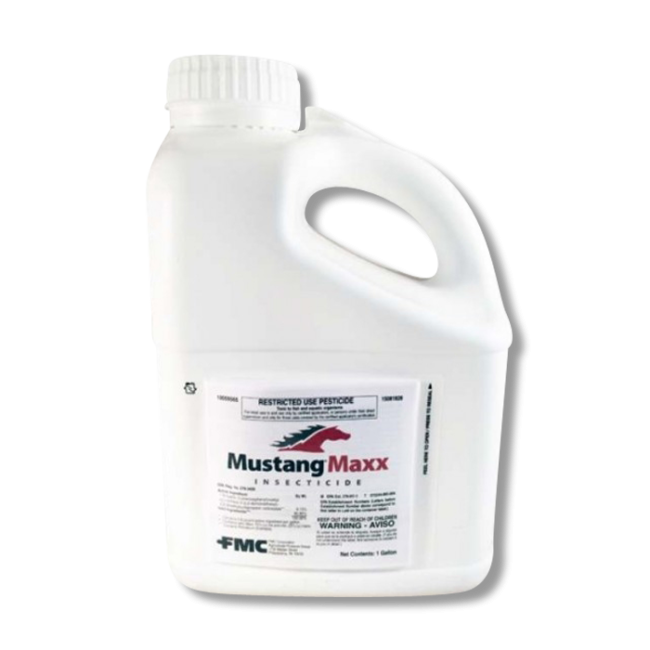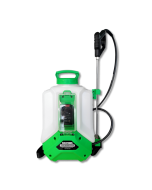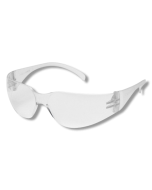Gain access to personalized product screening, the best pricing, rewards, and more!







application2
Mustang Maxx
Mustang Maxx is a pyrethroid-based insecticide concentrate that works on contact to kill more than 100 pests on 200 types of crops. It is easy to mix and use and is safe for plants.
11/02/25
This product is a Restricted Use Product and you are required to have a Certified Applicator's License to purchase this product.
Mustang Maxx, manufactured by FMC, is a broad-spectrum insecticide that targets more than 100+ species of pests and has become the unsung insecticide ally of farmers everywhere.
Mustang Maxx was created with the agricultural market in mind. It can be safely applied to more than 200+ species of crops, ornamentals, trees, fruits, and vegetables (including five key vegetable groups), such as soybeans, corn, alfalfa, rice-wheat, sunflowers, and pasture, making it the most crop—and farm-friendly insecticide in the market.
If you manage crops and have been dealing with pests, this is the product for you because it contains pyrethroids that leave a long residual control of a wide spectrum of infesting pests.
Tools Needed
You will need to mix it in a tank sprayer such as a hand pump sprayer, backpack sprayer or professional pesticide spraying rig for large applications.
How to Use
- Step 1: Determine how much Mustang Maxx you will need for your application depending on the treatment area size and the type of pest you are treating for. To do this, measure the length and width of the treatment area in feet then multiply them together (length x width = square footage). For acreage, take the total square footage calculated and divide by 43,560 (square footage / 43,560 = Acreage). Mustang Maxx can be applied anywhere from 0.23 fl oz. to 4 fl oz. per acre in at least 10 gallons of water per acre depending on the pest, where you are spraying, and the severity of the infestation.
- Step 2: Fill your sprayer tank halfway with the required amount of water and then add the appropriate amount of Mustang Maxx based on your calculations. Fill the sprayer with the remaining half of water and then agitate well until the solution is mixed thoroughly.
- Step 3: Apply a spot treatment or broadcast over your agricultural plants. Use a low rate under light to moderate infestations and higher rates under heavy infestations. Reapply as needed for continued control or when insect activity ceases.
Where to Use
Mustang Maxx is for agricultural use only. It is approved for use on Alfalfa and Nongrass animal feeds, artichoke, globe, Avocado, Barkley, Berries, Black Sapote, Brassica Vegetables, Buckwheat, Bulb vegetables, Canistel; Canola, Corn, Cotton, Cucurbit Vegetables, Fruiting Vegetables, Grapes, Grass Forage, Fodder and Hay and Grass Grown for Seed, Leafy vegetables, Legume Vegetables, Mamey Sapote, Mango, Oats, Papaya, Peanut, Pistachios, Pome Fruits, Rice, Root and Tuber Vegetables, Rye, Safflower, Sapodilla, Sorghum, Soybeans, Star Apple, Stone Fruits, Sugar Beets, Sugarcane, Sunflower, Tree Nuts and Wheat.
When to Use
Use when you have an infestation of pests around your growing crops. Apply on a calm day to limit drift. Higher volumes of finished spray may improve insect control under high temperatures, when foliage is dense, or when insect pressure is high.
Safety Information
Mustang Maxx is safe to use around children and pets when applied according to the product label instructions. Always wear the proper personal protective equipment (PPE) when mixing and applying this product.
Do not allow people or pets to enter treated areas until the spray has dried for at least 24 hours.
Special Considerations
This product comes in a 1-gallon bottle that should be adequate for most jobs. The average application rate varies from 1.28 fluid ounces to 4 fluid ounces of product per acre.
| Availability | Online |
| Restricted Use | Yes |
| Shipping Restrictions * = not registered** = restricted use | 1 Gallon: AK*, CT**, DC*, KA**, KY**, MI*, NY*, VT** |
| Brand | FMC TECHNOLOGIES |
| Keith's Pro Tips | "Mustang Maxx can be applied through air, ground, and chemigation. When spraying, place the nozzle on a fan spray setting for even coverage, and don't forget to spray the base and underside of plants where insects like to hide." |
| Product Drawbacks | Product needs to be repeatedly agitated during treatment to remain mixed in sprayer tank. |
| Target Pests | Alfalfa Caterpillar, Alfalfa Looper, Alfalfa Weevil, Aphid Spp., Aphids, Army Cutworm, Armyworms, Artichoke Plume Moth, Asian Lady Bird Beetle, Avacado Leafhopper, Avacado Loopers, Avocado Lace Bug, Avocado Tree Girdler, Avocado Whitedly, Avovado Leafroller, Bean Leaf Beetle, Beet Armyworm, Blue Alfalfa Aphid, Boll Weevil, Brown Soft Scale, Cabbage Looper, Cabbage Webworm, Caterpillars, Cereal Leaf Beetle, Chinch Bug, Corn Earworm, Corn Rootworm, Corn Rootworm Beetle, Corn Silkfly, Cotton Aphid, Cotton Bollworm, Cotton Fleahopper, Cotton Leaf Perforator, Crickets, Cucumber Beetles, Cutworm, Cutworm Species, Cutworms, Diamondback Moth, Eastern Grape Leafhopper, Egyptian Alfalfa Weevil, European Corn Borer, European Corn Borrer, Fall Armyworm, Flea Beetle, Flea Beetles, Grape Berry Moth, Grass Sawfly, Grasshopper Spp., Grasshoppers, Green Cloverworm, Green Peach Aphid, Greenbug, Ground Beetles, Hop Vine Borer, Hornworms, Imported Cabbageworm, Japanese Beetle, Lady Bird Beetle, Leafhoppers, Leafminers, Lepidopterous Larvae, Loopers, Lygus Bug, Lygus Bugs, Lygus Spp., Meadow Spittlebug, Melonworm, Mirids, Omnivorous Loopers, Onion Maggot, Onion Thrips, Orange Tortrix, Painted Lady Caterpillar, Pale Western Cutworm, Pea Aphid, Pickleworm, Pink Bollworm, Plant Bug, Plant Bugs, Potato Leafhopper, Proba Bug, Rindworm, Root Weevils, Saltmarsh Caterpillar, Sap Beetle, Scale Crawlers, Seedpod Weevil, Southern Armyworm, Southern Cabbageworm, Southern Corn Leaf Beetle, Southwestern Corn Borer, Spanworm, Spittlebug, Spotted Alfalfa Aphid, Spotted Wing Drosophil, Spotted Wing Drosophila, Squash Bug, Squash Vine Borer, Stalk Borer, Stink Bug, Stink Bugs, Stinkbugs, Tarnished Plant Bug, Thistle Caterpillar, Threeconcerned Alfalfa Hopper, Thrips, Thrips Spp, Tobacco Budworm, Tomacco Budwrm, True Armyworm, Twig Borers, Variegated Leafhopper, Velvetbean Caterpillar, Vinegar Flies, Webworm, Webworms, Western Grape Leafhopper, Wheat Stem Sawfly, Whiteflies, Whitefly, Wireworm, and Yellow Striped Armyworm. |
| Application Equipment | Backpack Sprayer, Spray Rig |
| Application Methods | Broadcast Spray, Spot Treatment |
| Active Ingredient | Zeta-cypermetherin S-Cyano (3-phenoxy-phenyl) methy (+) cis/trans 3- (2,2-dichloro-etheny) -2,2 dimethylcyclopropane carboxylate 9.15% |
| Product Type | Insecticide |
| Formulation | Emulsifiable Concentrate (EC) |
| Application Rate | Mustang Maxx will be used at a rate 0.02 up to 4 oz per acre. The amount of water used will depend on the targeted pest or crop. For more specific application rates please refer to the label. |
| Shelf Life | Mustang Maxx will last for up to 1 to 2 years when stored according to the product label. Keep Mustang Maxx stored in a cool, dry storage area. |
| Yield | 1 gallon of Mustang Maxx can treat up to 32 acres of land when using the maximum 4 oz. per acre rate. |
| Use Sites | Outdoors |
| Time to Kill | Mustang Maxx can kill insects on contact or within a couple of days depending on the pest. |
| Comparable Products | Acephate 97UP Insecticide |
| Incompatible Home Siding | Brick, Hardie Plank, Stone Veneer, Stucco, Wood, Vinyl |
| EPA Registration # | 279-3426 |
| Restricted Use | Yes |
|---|---|
| Shipping Restrictions | AK, CT, DC, KA, KY, MI, NY |
| Availability | Online |
| Signal Word | WARNING |
| Keith's Pro Tip | "Mustang Maxx can be applied through air, ground, and chemigation. When spraying, place the nozzle on a fan spray setting for even coverage, and don't forget to spray the base and underside of plants where insects like to hide." |
| Target Pests Multi | Alfalfa Caterpillars, Alfalfa Looper, Alfalfa Weevil, American Plum Borers, Aphids, Apple Maggots, Army Cutworm, Armyworms, Artichoke Plume Moth, Avocado Lace Bug, Avocado Leafhopper, Avocado Loopers, Avocado Tree Girdler, Avocado Whitefly, Banded Sunflower Moth, Bean Leaf Beetle, Beet Armyworms, Bermudagrass Stem Maggot Fly, Black Cherry Aphid, Black Peach Aphid, Black Pecan Aphid, Blister Beetles, Blue Alfalfa Aphid, Boll Weevil, Brown Soft Scales, Cabbage Looper, Cabbage Webworm, Caterpillars, Celery Leaf Tier, Cereal Leaf Beetle, Cherry Fruit Flies, Chinch Bugs, Click Beetles, Codling Moths, Colorado Potato Beetle, Corn Earworm, Corn Rootworm, Corn Silkfly, Cotton Aphid, Cotton Bollworm, Cotton Fleahopper, Cotton Leafperforator, Cowpea Curculios, Crickets, Cucumber Beetles, Cutworms, Diamondback Moths, Egyptian Alfalfa Weevil, Egyptian Alfalfa Weevil Larvae, European Apple Sawfly, European Corn Borer, Fall Armyworms, Filbert Worms, Flea Beetle, Garden Webworm, Grass Mealybug, Grass Sawfly, Grasshoppers, Green Bug, Green Cloverworm, Green Fruitworms, Green Peach Aphid, Green Stink Bug, Grey Sunflower Seed Weevil, Ground Beetles, Head-Clipper Weevil, Heliothis, Hickory Shuckworms, Hop Vine Borer, Hornworm, Imported Cabbageworms, Japanese Beetle, Kudzu Bugs, Leaffooted Bug, Leafhoppers, Leafminers, Leafrollers, Lepidopterous Larvae, Lesser Apple Worms, Lesser Cornstalk Borer, Lesser Peach Tree Borer, Longhorned Beetles, Loopers, Lygus Bugs, Meadow Spittlebug, Melon Worm, Mexican Bean Beetles, Mexican Rice Borer, Mirids, Navel Orangeworms, Oat Birdcherry Aphid, Obliquebanded Leafroller, Omnivorous Loopers, Onion Maggot, Onion Thrips, Orange Tortrix, Oriental Fruit Moths, Painted Lady Caterpillars, Pale Striped Flea Beetle, Pale Western Cutworm, Pandemis Leafroller, Pea Aphid, Pea Leaf Weevil, Pea Weevils, Peach Tree Borers, Peach Twig Borer, Pear Psylla, Pecan Leaf Casebearer, Pecan Nutcasebearers, Pecan Phylloxera, Pecan Weevils, Pepper Maggot, Pepper Weevils, Pickleworms, Pink Bollworm, Plant Bugs, Plum Curculio, Potato Leafhopper, Proba Bug, Red Sunflower Seed Weevil, Redbanded Leafroller, Rednecked Peanut Worm, Rice Stalk Borer, Rice Stink Bugs, Rice Water Weevil, Rindworms, Rose Chafers, Rosy Apple Aphid, Salt Marsh Caterpillars, Sap Beetles, Scale Crawlers, Seed Corn Beetle, Seedcorn Maggot, Seedpod Weevil, Silverspotted Skipper, Sorghum Midge, Southern Armyworm, Southern Cabbageworm, Southern Corn Leaf Beetle, Southern Corn Rootworm Beetle, Southwestern Corn Borer, Soybean Aphid, Soybean Looper, Spanworm, Spirea Aphid, Spittlebugs, Spotted Alfalfa Aphid, Spotted Tentiform Leafminer, Spotted Wing Drosophila, Squash Bug, Squash Vine Borer, Stalk Borer, Stem Weevil, Stink Bugs, Sugar Beet Crown Borer, Sugar Beet Root Maggot, Sugar Beet Root Maggot Larvae, Sugarcane Borer, Sunflower Beetle, Sunflower Butterfly, Sunflower Maggot, Sunflower Moth, Tarnished_Plant_Bugs, Thistle Caterpillar, Threecornered Alfalfa Hopper, Thrips, Tobacco Budworm, Tobacco Thrips, Tomato Fruitworm, Tomato Pinworm, Tomato Psyllid, Tufted Apple Bud Moths, Twig Borers, Variegated Leafroller, Vegetable Weevils, Velvet Bean Caterpillars, Vinegar Flies, Walnut Aphid, Walnut Husk Flies, Webworms, Western Beancutworms, Western Cherry Fruit Fly, Wheat Stem Sawfly, White Apple Leafhopper, White Grubs, Whiteflies, Whitefringed Beetle, Wild Rice Worm, Wireworms, Woolly Bear Caterpillar, Yellow Pecan Aphid, Yellow Striped Armyworm, Zebra Caterpillar |
| Time to Kill | Mustang Maxx can kill insects on contact or within a couple of days depending on the pest. |
| Chemical Type | Insecticide |
| Formulation | Emulsifiable Concentrate (EC) |
| Application Methods | Broadcast Spray, Spot Treatment |
| Product Drawbacks | Product needs to be repeatedly agitated during treatment to remain mixed in sprayer tank. |
| Active Ingredient | Zeta-cypermetherin S-Cyano (3-phenoxy-phenyl) methy (+) cis/trans 3- (2,2-dichloro-etheny) -2,2 dimethylcyclopropane carboxylate 9.15% |
| Application Equipment | Backpack Sprayer, Spray Rig |
| Mix Rate | Mustang Maxx will be used at a rate 0.02 up to 4 oz per acre. The amount of water used will depend on the targeted pest or crop. For more specific application rates please refer to the label. |
| Use Sites | Outdoors |
| Yield | 1 gallon of Mustang Maxx can treat up to 32 acres of land when using the maximum 4 oz. per acre rate. |
| EPA Registration No. | 279-3426 |
| Shelf Life | Mustang Maxx will last for up to 1 to 2 years when stored according to the product label. Keep Mustang Maxx stored in a cool, dry storage area. |
| Comparable Products | Acephate 97UP Insecticide |
| Children or pets? | No |
| Property Characteristics | None |
*Price does not include freight. We guarantee our rate plus shipping will be less than anyone else's price.









